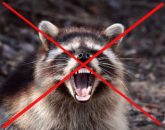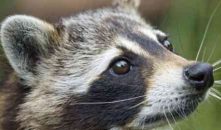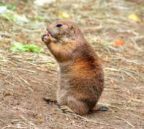The raccoon is a species of omnivorous mammals native to America. Its species was introduced for the
last time in Europe in the 1930s (after the disappearance of the last introduced population a century
earlier).
It owes its name to its habit of dipping its food in the water before eating it. The animal, which is the
family of Procyonidae, is mainly nocturnal and easily climbs trees with its nimble fingers and sharp
claws. It is easily recognized by its black mask edged with white around the eyes and its tail alternating
clear and black rings.
The raccoon adapts to many natural environments. Opportunistic and easy to tame, it ventures into
North American cities in Canada and the United States.
Its behavior varies according to the sex and the region where it lives. It is always hunted for its fur.
The Procyonidae member is represented by 3 living species:
Procyon cancrivorus, raccoon granchiaiolo
Procyon lotor
Procyon pygmaeus (= P. maynardi )
Description
The adult raccoon measures 80 cm on average with variations between 60 cm and 105 cm (tail
included) depending on the individual. Males are larger and heavier than females.
The mass of the raccoon is between 3.9 and 9 kg on average. The largest individuals live in the northern
regions (8.5 kg on average in Canada) and record up to 28 kg.
The weight fluctuates according to the season, reaching a maximum in autumn: its mass can increase by
50% in the regions to the north.
The fur is usually gray-brown, pulling more or less to gray or brown. The white face has large black spots
around the eyes in the form of a mask and a black band on the nose. Some individuals are white, but
albinism is very rare. The molt begins in the spring and can last for three months. The summer coat of
the raccoon is short.
The raccoon should not be confused with the raccoon dog (or tanuki), a canine whose fur is browner,
the facial scratch interrupted on the muzzle and the tail shorter and of solid color.
The head: The head is broad, the muzzle is pointed, the eyes are black and the short ears
measure around 4 to 6 cm. The animal has long canines like all carnivores.
The legs: Its legs have five fingers with non-retractable claws. The feet measure between 100
and 125 mm.
The tail: The tail of the raccoon is usually 20 to 28cm long and can measure up to 40 cm. It has 5
to 7 brown or black rings and its end is always black.
Distribution and habitats
Native to North America, the species occupies southern Canada and most of the United States, Mexico,
and Central America in the intertropical zone. It is rarer in the West Indies, where it is a protected
species. It is absent from certain areas of the Rocky Mountains due to altitude, deserts and the Canadian
Far North. In Europe, it is naturalized in Switzerland, France, Germany, Belgium, the Netherlands,
Denmark, Austria, the Czech Republic, Slovakia, Belorussia as well as in the countries of the Caucasus. It
has never lived naturally in Japan.
The raccoon frequents mixed forest, deciduous forest and agricultural areas. It is found along forest
edges, in streams and in swamps in almost all latitudes of North America. It can also live in urban parks
and suburbs.
The territory of the raccoon varies between 1 and 50 km according to human densities. The female does
not defend territory.
In the 1930s, the raccoon was introduced again in the USSR and Germany for its fur, in breeding farms.
Perfectly acclimated and in the absence of predators, it has proliferated since. Today, there are around
100,000 raccoons in Europe. The species is present in Luxembourg, Germany, the Netherlands, France
(Aisne where it was released near Laon-Couvron Air Base by members of the United States Air Force), in
Switzerland, Poland, and Belgium.
What do the raccoons eat?
The raccoon eats everything or almost everything: meat, fish, shellfish, eggs, shrimp, birds, insects,
plants, fruits, seeds, and often rummages through man's waste.
Omnivorous, the raccoon has a varied diet but prefers invertebrates, insects, worms, and larvae. Being
protected from stings by its thick fur, it also attacks insect nests.
It eats small aquatic animals: clams of freshwater, mussels, crayfish, fish, frogs, turtles, amphibians and
oysters. It also feeds on small mammals (muskrats, field mice). It can also tackle chickens. In summer
and autumn, it favors corn, fruits, berries, acorns, and nuts. In the cities, it searches the garbage cans
which it easily opens with its nimble fingers. It sometimes eats carrions.
The popular belief that raccoons wash their food before consuming it comes from the fact that they
usually feed on small aquatic animals and often rub their food in their hands as if to knead it. Thus,
cluster shells of clams on the shore of a river or rods broken in the fields of corn are signs of its
presence.
Where do raccoons live?
The raccoon often chooses a hollow tree for shelter. It is housed in the hollow trees, the stumps, caves,
burrows of marmots abandoned barns or sheds and often changes shelter.
Around mid-October, the animal takes refuge in its shelter and sleeps the winter in a state of torpor,
waking only from time to time. Like the black bear and the badger, it stops eating and survives thanks to
its accumulated fat reserves during the summer. Contrary to what we have long believed, the
temperature of its body and its metabolism remain high. The males leave their lodge in late January,
females around mid-March.
In the city, you can find the animal in the attics, sewers, and chimneys it reaches with claws that allow it
to climb easily several meters above the ground. Each deposit hosts between one and five individuals
(up to 23 in Minnesota). It frequents several shelters outside of winter.
How do they reproduce?
The raccoon reproduces in spring. Its young ones are generally four and remain with the mother until
the end of the following winter. It spends the winter in the den, in the heat, but doesn't go into
hibernation. Some scientists have discovered that raccoons have the possibility of rapid evolution
because they have prehensile hands and can maneuver objects. If accepted as a child it adapts to living
with men.
Mating takes place in January or February in the northern regions, and in March in the other regions.
Females have only one litter per year and can have pups in their first year. The male is polygamous and
can breed in its second year. The monogamous female is receptive for 3 to 6 days and gestation lasts 63
days.
A litter comprises between one and three cubs in the south against three to seven in the north and
sometimes up to nine. The young are born in April or May. They are blind, weigh between 60 and 75 gm
and have hairy backs and flanks. The first teeth appear after about twenty days. Their eyes open at three
weeks. Raccoons tend to rear their offspring who are weaned at four months of age.
Their call is similar to birds chirping and they feed on breast milk. Ratchets can in turn breed at one or
two years of age, depending on the sex. They spend their first winter with their mother and do not
disperse until the beginning of the following summer.
Characteristics
The raccoon is not shy and can settle in attics or fireplaces. Their pups are easily tamed by men. In
adulthood, males become aggressive and return easily to wildlife after a time of captivity.
The raccoon is a good climber and a good swimmer. On land, it moves quite slowly, which makes it
vulnerable. It can descend from a trunk; the head first, turning its feet from behind to 180°.
Being a curious and intelligent animal, it comes out of its den especially at night, except during the
breeding season and in town. The raccoon grunts when in danger.
In summer and autumn, it stores fat reserves for the bad season and can gain up to twice its original
weight. The thickness of the fat layer can reach 2.5 cm on the back. In winter, the raccoon does not
hibernate but enters a period of inactivity and dormancy, except in the southern areas where the animal
continues to be active.
Is the raccoon eaten?
Although mainly hunted for its fur, raccoons have also long been an important food source for Native
Americans and Americans and the barbequed raccoon was a traditional dish on American farms.
It used to be a festive meal. American slaves ate raccoon at Christmas. However, it was not usually a
dish for poor people or peasants; In the daily The Golden Era of San Francisco of 21 December 1856, the
raccoon is one of the recommended dishes for parties and raccoon Rebecca received by US President
Calvin Coolidge had been sent originally and served at Thanksgiving dinner for the White House.
The foremost edition of the book, The Joy of Cooking, published in 1931, included the recipe for
preparation of the raccoon with squirrel and opossum. She suggested removing the musk glands and fat
before roasting the animal and accompanying it with sweet potatoes.
Due to the fact that raccoons are usually considered endearing, cute or verminous, many ordinary
consumers have a repulsive fear of eating them. However, several thousand raccoons are still consumed
every year in the US. Although the Coon Feed in Delafield, Wisconsin is a yearly event which started in
1928, its main culinary use is found in parts of the southern United States such as Arkansas. Here, the
Gillett Coon Supper is considered a special political event.
Each year, 2 to 4 million of the animals are killed by motorists or hunters. The raccoon is perceived as a
threat to farmers when it attacks orchards, eggs, cornfields, granaries, sugar shacks or hives. In
Switzerland, it is hunted and considered undesirable for the natural balance.
What diseases do raccoons transmit?
The raccoon may carry rabies, distemper or scabies but also parasites (parvovirus infection,
leptospirosis, and Baylisascaris procyonis). According to the Canadian Food Inspection Agency, rabies is
transmissible to humans through saliva.
Crossing legends
Several legends describe the origins of the Maine coon cat breed. The most common tells that the
Maine Coon is the result of a cross between cats and raccoons (colloquially coon in English, abbreviated
raccoon), which would explain their color (the most common is the brown tabby) and their very bushy
tail. Of course, it is genetically impossible to achieve such a hybrid, but the breed keeps its legend's
name.
Threats
The raccoon generally lives between 3 and 5 years in the wild and sometimes up to 14 or 16 years. In
captivity, it can exceed 16 years to 21 years. Their young ones usually die from malnutrition, illness or
are killed by a predator.
Predators
The main predator of the raccoon is man. In pre-Columbian times, it was hunted by Native Americans
who appreciated its flesh and fur. In modern times, the trappers and woodsmen captured it while
practicing the fur trade. The peak of this trade was reached in the 1920s; between 1941 and 1989 more
than 1.7 million were killed for their furs in the state of Nebraska alone. Today, because the fur of the
rat has little value and is difficult to work, the activity has fallen into disuse.
Formerly sought after by humans for their fur, the raccoon is still preyed upon by American marten,
bobcat, cougar, coyote, gray wolf, red fox, and domestic dog. The Great Horned Owl sometimes catches
its cubs. It is attacked by alligators in the southern United States.
What is the conservation status of the raccoon?
Today, it is considered a threat to biodiversity and has been classified by the Council of Europe as an
invasive species whose eradication is recommended because of its impact on local fauna. In France, it
has been classified as a pest since June 2016.






